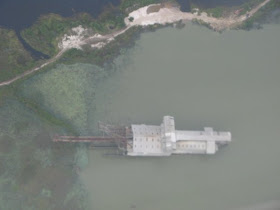Today very few mines are working and most of the artefacts are lost. There are only about 3 dredges left.
 |
| 1960s postcard |

dredge seen from air approaching KLIA in Selangor -
Many of these pictures are old photos that I have scanned so the quality is not good (and I haven't bothered to play around with any photoshop type software), but they are here for the record.
Ipoh museum display -
gravel pump used in New Lahat mine
trolley used in 1925

The next few photos were taken at New Lahat mine in Perak in 1997 -
buckets of ore
the kitchen
"pig basket" strainer, now abandoned
palong, a series of sluices
a "pig basket" in this revolving steel drum the gravel is broken into small pieces -
Open cast pit of New Lahat mines
tin mine workers -
Tin mine Perak
Tin mine Ulu Selangor
Merapoh Mine near Kpg Kepayang in Perak, 1997 -
jets of water under pressure break up the tin-bearing soil
the extraction area where jets of water under pressure are shot at the sides of the mine to break up the tin-bearing soil
the muddy mixture collects in a pool, called a sump
controlling the water monitor
from the sump the slurry is pumped up to the palong -
the slurrychannels leading to the sluices (above),
overview of the channels and sluices -
gravel containing the tin
© Liz Price
No reproduction without permission






















































Yes, I had seen this one about a year ago. I worked in a palong tin mine before in Pangkalan, Ipoh, now a township.
ReplyDeleteOpen tin mining site - use water jet to send debries and water to the palong.
ReplyDeletePalong is to trap heavier tin and the rubbish ( stone and sand) is washed down steam.
ReplyDeleteWash House is the final seperation and heat drying the tin for packing into small bags for sales.
ReplyDeleteThis is called the pig stomach and the pipe attached to it is called pig intestine. Most of the nameing parts are somewhat associated to pig.
ReplyDeleteThanks for all the info. Yeh, it's funny the parts have pig names, I wonder why.
ReplyDeleteLike you the favourate food of the tin mining people is also pork. Every day at lunch time one or two pigs ! Every one scrambled for the fat part, the lean meat was reluctantly taken. Those components resemble the like of a pig.
ReplyDeleteFantastic coverage about Malaysian mining heritage.
ReplyDelete